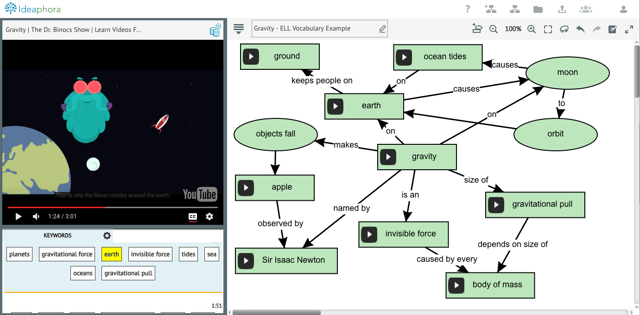As the fastest growing student population in America’s schools, English Language Learners are critical to America’s future economic and civil prosperity. While the achievement gap between native and non-native English speaking students has narrowed, a social and academic chasm persists. Concept mapping is an effective strategy for educators to use to support language learners and prepare them for success in school and beyond.
There are several research-based methods for applying concept mapping to language learning. Here are some of the ways teachers can use concept mapping to differentiate instruction for ELL students:
Pre-Reading
- Invite students to share what they already know about a particular concept in a concept map prior to reading. This approach provides students with the concepts and words that they are about to encounter in the reading text as well as an overview of the content to be learned. Then, ask students to add information to their maps while reading to provide a visual aid for building on their prior knowledge. This could be an individual or whole class assignment.
Pre-Writing
- Task students with brainstorming about a given topic by making connections among ideas and analyzing information in a concept map in preparation for writing. Allow students to discuss their maps in groups and share their ideas for writing so they can hone or expand their focus as needed. After researching their topic, students can modify their maps to capture new information and organize their thoughts before writing their compositions. Research has shown that this appraoch helps ELL students improve their writing.

Vocabulary Building
- Enable students to create concept maps to define and better understand key vocabulary terms. Students can access videos, text and images to learn about a term and then build a map that visually links the term to its various meanings, uses, related words, synonyms and more. This allows students to personalize their connection to the vocabulary words, improving their recall and comprehension. The map provided in this post is an example of this approach.
Developing Critical Thinking
- Encourage students to create a concept map of a unit or topic with key terms and essential questions during and after a series of lessons. Help them to see the big picture of the topic as well as build a scaffolding of meaning, a governing framework for future success by emphasizing the main ideas, key concepts and principles. By visually expressing the association of related concepts, concept maps help learners to find unseen connections between ideas, organize information easily, and create new knowledge, which in turn, clarify their thinking. This process of making knowledge explicit fosters the understanding of complex information for ELL students without elaborative written explanations. The concept maps are also useful visual aids that make later study and recall easier for language learners than with linear notes.
Assessment
- Use concept maps to ascertain student understanding of a concept or unit taught. By making students’ thinking and learning visible, concept maps reveal to teachers, and to the students themselves, the gaps in understanding at any given moment. After re-teaching or employing interventions, have students adjust their concept maps to assess their knowledge development over time.
Reading Comprehension
- Ask students to build a concept map as they read a book or text, identifying main ideas, finding sub-concepts, and linking related ideas together. An earlier post on close reading strategies shows how this method can help all learners, particularly ELL/ESL students, improve reading comprehension.
Try any of these methods with your ELL students to help them develop content-area knowledge, literacy skills and critical thinking as well as to evaluate their learning needs and progress. Ideaphora Classroom provides a streamlined, effective learning environment for ELL students to build concept maps from digital content. With 9,000 vetted educational resources available in Ideaphora, and growing, teachers can easily identify and assign content to students to use in their maps, or allow learners to find their own resources. Sign up to participate in our free Classroom Pilot Program to use Ideaphora with your language learners.

